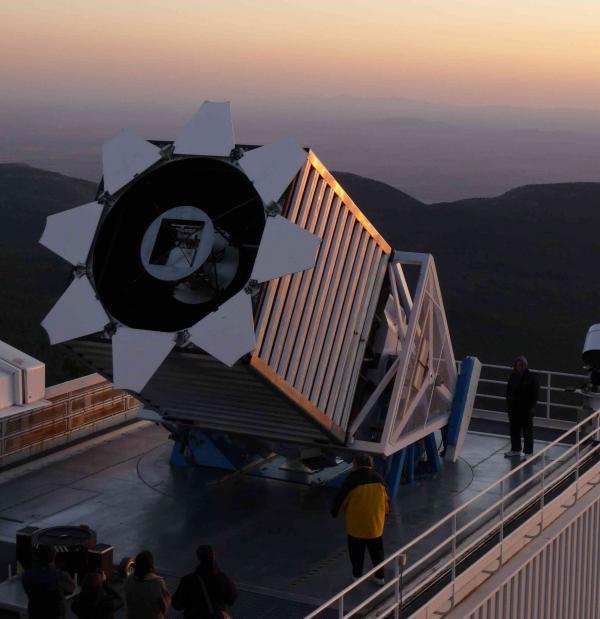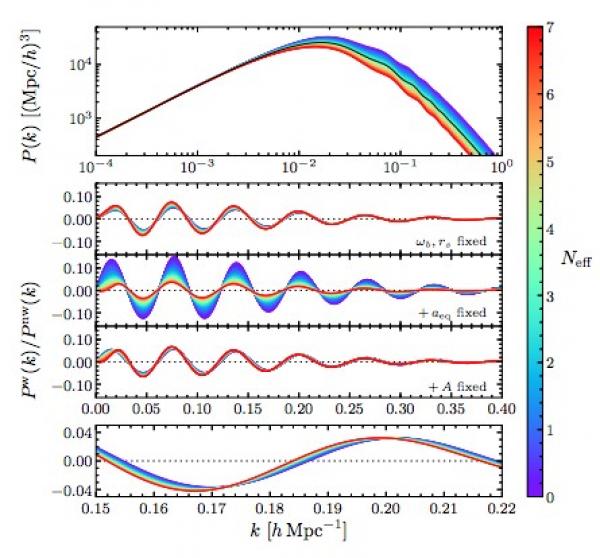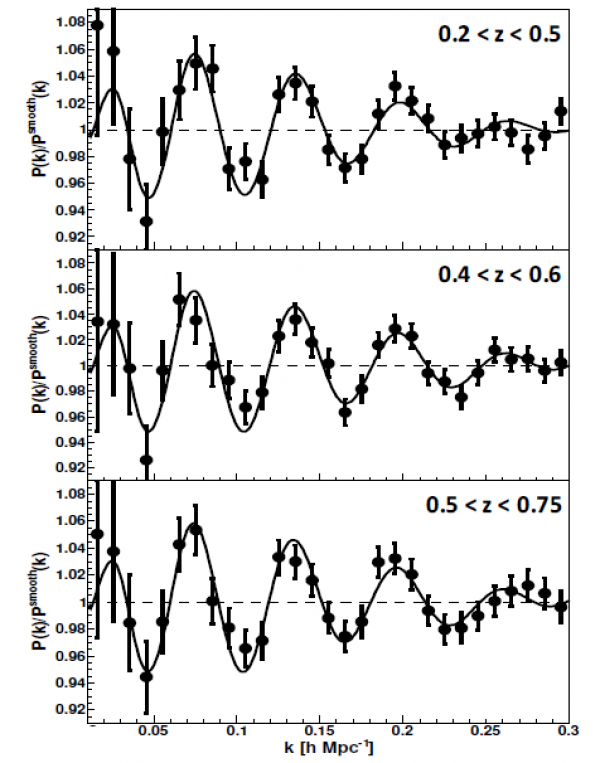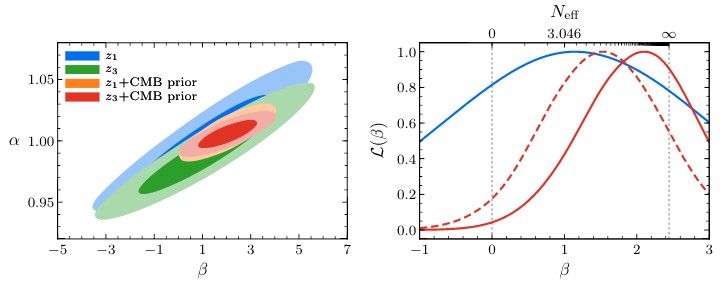
Sloan Digital Sky Survey telescope located at the Apache Point Observatory in New Mexico, USA. It allows among other things to study quasars (credit: SDSS Collaboration).
Neutrinos from the Big Bang have been traveling the Universe for more than 13 billion years. They are almost undetectable but their footprint on the formation of large structures in the Universe, such as galaxies, can be detected. For the first time, this trace of the "diffuse neutrino background" from the Big Bang on the "baryonic acoustic oscillations" (BAO) has been deduced from the survey of 1.2 million galaxies of the "Sloan Digital Sky Survey" (SDSS). These data correspond to 5 years of observations from the Baryon Oscillation Spectroscopic Survey (BOSS) experiment, a ground-based telescope installed in New Mexico. The result, published in the journal Nature Physics, shows how the BAO phase can constrain the number of neutrino species in the Standard Model of Particle Physics.
The DPhP group has been involved in this project for more than 10 years and is currently working on its extension, the eBOSS project. In the very near future, the DESI project will be able to study even more precisely this cosmic neutrino background produced by the Big Bang.
The primordial Universe is composed of a plasma of baryons, electrons, photons and neutrinos, which make up ordinary matter, as well as dark matter. Within this medium of ordinary matter, pressure waves (acoustic waves) propagated from tiny variations in density corresponding to the primordial fluctuations resulting from cosmic inflation. Due to its expansion, the Universe cools down over time and, at the age of 380,000 years, its temperature drops below the minimum threshold to maintain it in a state of ionized plasma: electrons associate with protons to form hydrogen atoms, and the initial plasma suddenly turns into a neutral medium. The propagation of these acoustic waves then stops, after having travelled a distance corresponding to 150 Mpc today. The Universe thus bears the imprint of these "baryonic acoustic oscillations" (BAO). The spatial distribution of the galaxies that formed from these primordial fluctuations is then no longer random and there is a privileged distance between matter concentrations. The measurement of this characteristic scale at different times in the evolution of the Universe is today a means to characterize the acceleration of the expansion of the Universe (highlights 2012, 2014, 2017).
This is the challenge for BOSS and eBOSS, who have been observing millions of galaxies and quasars since 2009, using a specially designed spectrograph on the 2.5-meter Sloan Telescope at the Apache Point Observatory in New Mexico, USA. The study presented in the paper uses 1.2M BOSS galaxies whose redshift, an indicator of the distance along the line-of-sight to us, is determined from their spectra and is between 0.2 and 0.75. The light that reaches us from these objects was thus emitted about 5 billion years ago. The redshift complements the two transverse coordinates given by the position of the galaxy on the celestial vault and a 3D map can thus be drawn up over the course of the observations.
If we measure the correlation function of the 3D distribution of galaxies, i.e. if we count the number of pairs of galaxies as a function of the distance between them, the BAO signal appears as a 150 Mpc peak, proving the existence of this footprint formed at the time of the creation of the first hydrogen atoms. If we consider the Fourier transform of this correlation function, the power spectrum, the peak will appear as an oscillation signal (see figure 1) whose frequency informs us about the characteristic scale of the BAO. And it is the phase (i.e. the offset) of these oscillations that makes it possible to constrain Neff, the effective number of relativistic species at the time of recombination.
In the standard model of cosmology, this Neff number corresponds to the three known neutrino flavors. A key property of neutrinos is that they do not behave like a fluid, but like a set of freely scattering relativistic particles. Neutrinos move at the speed of light while acoustic baryonic oscillations in a fluid of photons and baryons move at ~c/√(3). As a result, relativistic neutrinos induce perturbations beyond the sound horizon of the acoustic waves propagating in the photon-baryon fluid. This effect results in the end in a phase shift in the acoustic waves of the primordial plasma.

Figure 1: Impact of the effective number of relativistic species (Neff) in the power spectrum of matter (top). The other graphs show the evolution of the power spectrum divided by a power spectrum without any effect of baryons, thus characterizing the phenomenon of baryonic acoustic oscillations. The lower figure clearly shows that the phase (the shift) of the signal of baryonic acoustic oscillations depends on Neff, the number of relativistic species (vertical color scale) (Baumann et al. 2017).

Figure 2: Power spectrum of galaxies observed by BOSS for three redshift regions where the baryonic acoustic oscillations are clearly visible (F. Beutler et al. 2017). The phase of these oscillations tells us about the effective number of relativistic species.
In order to measure this effect, we used the 3D map of the 1.2M galaxies observed by BOSS. Figure 2 shows the power spectrum of these galaxies. In practice, we used the two regions in redshift 0.2.
Our measurement from BOSS data alone cannot really constrain Neff . However, figure 3 also shows that there is a strong degeneracy between the parameter β and the BAO scaling parameter α. Within the framework of the standard model of cosmology, the Cosmic Microwave Background (CMB) measurement gives us a strong constraint on the alpha parameter that we can combine with our measurement. The result is a more precise constraint on the phase which gives β = 2.05 ± 0.81. The red curves in figure 3-b are obtained for different hypotheses on the use of CMB data (details are in the article) and show that in all cases, we exclude β = 0 (corresponding to Neff = 0) at more than 95% confidence level. By measuring a non-zero β phase, we thus observe for the first time the neutrino fingerprint in baryonic acoustic oscillations with a galaxy survey.

Figure 3: a) Constraints on the measurement of the BAO scale ? and the BAO phase ? using only the BOSS galaxy power spectrum or the combination with the Cosmic Microwave Background (CMB). b) Constraint on the BAO phase ?, the blue curve is for BOSS alone and the red curves are obtained for different assumptions on the use of the CMB data and show that in all cases ? = 0 (corresponding to Neff = 0) is excluded at more than 95% confidence level.
In summary, we have for the first time measured the phase shift of the BAO signal in the power spectrum of the galaxies observed by BOSS, which represents an (indirect) detection of the diffuse cosmic neutrino background produced by the Big Bang. Our measurement confirms the current standard model with three species of neutrinos. This first detection is still imprecise, but future large surveys of galaxies and quasars such as DESI and Euclid will significantly improve these measurements.
Contact : Christophe Yeche
• Structure and evolution of the Universe › Evolution of the large structures and galaxies The ultimate constituents of matter › Neutrino Physics
• Institute of Research into the Fundamental Laws of the Universe • The Particle Physics Division
• BAO
